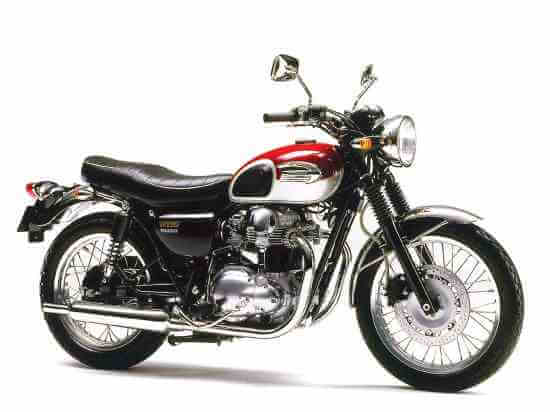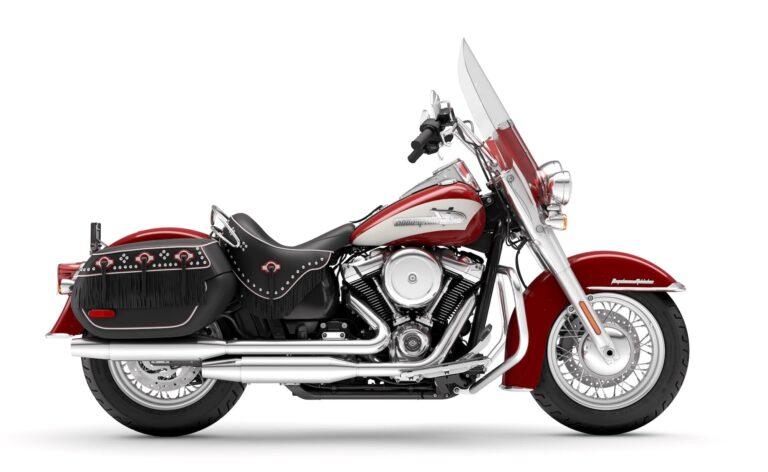Kawasaki W650 Maintenance Schedule and Service Intervals
This is the maintenance schedule with associated service intervals for the Kawasaki W650.
The Kawasaki W650 is a retro classic motorcycle made between model years 1999-2007 and superseded by the Kawasaki W800, although the W650 is the true classic according to many fans.
The W650 has a long-stroke engine with an anti-vibration balance shaft and modern electronics — apart from the carburettor. It has air-cooled SOHC, 8-valve vertical twin 676 cc engine with 360-degree crankshaft design, much like the Triumph Bonneville.
Kawasaki made no significant updates to the W650 during its production run so this maintenance schedule is the same for the whole series.
This site has links for things like oil and spark plugs from which we earn a commission (which unfortunately nobody can save, not even us). If you appreciate this work, then please use those links. Thanks!
Service intervals for the Kawasaki W650
The W650 has service intervals of 6000 km or 4000 miles, though the exact interval changes semi-randomly in the schedule (see below).
Essentially, every service, change the oil and check / clean / gap the spark plugs. Also do a list of other checks that you’ll see in the schedule below.
Every two services (7500 miles / 12000 km), change the oil filter, check the valve clearances, and synch the carburettors.
There’s no coolant to change in the air/oil-cooled W650. And brake fluid needs to be changed every two years, though check it regularly.
Maintenance Schedule for Kawasaki W650
Below is the maintenance schedule for the Kawasaki W650.
The following is the list of maintenance operations and to be done on this motorcycle with a time or distance interval — whichever comes earlier.
Notes:
- For higher odometer readings, repeat at the frequency interval established here
- For items marked “check” or “adjust” — torque, replace, or repair as needed.
- Kawasaki recommended you get a dealer to service any parts that may influence safety or emissions.
| mi x 1000 | 4 | 7.5 | 12 | 15 | 20 | 24 | |
|---|---|---|---|---|---|---|---|
| km x 1000 | 6 | 12 | 18 | 24 | 30 | 36 | Every |
| Engine oil — change (Kawasaki 10W-40 engine oil or Motul 7100 synthetic) | ✓ | ✓ | ✓ | ✓ | ✓ | ✓ | 6 months |
| Oil filter — replace | ✓ | ✓ | ✓ | ||||
| Spark plugs — clean and gap | ✓ | ✓ | ✓ | ✓ | ✓ | ✓ | |
| Valve clearance — check | ✓ | ✓ | ✓ | ||||
| Carburetor synchronization — check | ✓ | ✓ | ✓ | ||||
| Idle speed — check | ✓ | ✓ | ✓ | ||||
| Throttle grip play — check | ✓ | ✓ | ✓ | ||||
| Air suction valve — check | ✓ | ✓ | ✓ | ✓ | ✓ | ✓ | |
| Air cleaner element — clean | ✓ | ✓ | ✓ | ||||
| Evaporative emission control system — check | ✓ | ✓ | ✓ | ✓ | ✓ | ✓ | |
| Brake play — check | ✓ | ✓ | ✓ | ✓ | ✓ | ✓ | |
| Brake light switch — check | ✓ | ✓ | ✓ | ✓ | ✓ | ✓ | |
| Brake lining or pad wear — check | ✓ | ✓ | ✓ | ✓ | ✓ | ✓ | |
| Brake fluid level — check | ✓ | ✓ | ✓ | ✓ | ✓ | ✓ | Month |
| Brake fluid — change (Castrol DOT 4) | ✓ | 2 years | |||||
| Clutch — adjust | ✓ | ✓ | ✓ | ✓ | ✓ | ✓ | |
| Steering — check | ✓ | ✓ | ✓ | ✓ | ✓ | ✓ | |
| Drive chain wear — check | ✓ | ✓ | ✓ | ✓ | ✓ | ✓ | |
| Nuts, bolts, and fasteners tightness — check | ✓ | ✓ | ✓ | ||||
| Tire wear — check | ✓ | ✓ | ✓ | ✓ | ✓ | ✓ | |
| Spoke tightness and rim runout — check | ✓ | ✓ | ✓ | ✓ | ✓ | ✓ | |
| General Lubrication — perform | ✓ | ✓ | ✓ | ||||
| Front fork oil — change | ✓ | 2 years | |||||
| Front fork oil leak — check | ✓ | ✓ | ✓ | ||||
| Rear shock absorber oil leak — check | ✓ | ✓ | ✓ | ||||
| Swingarm pivot — lubricate | ✓ | ✓ | ✓ | ||||
| Steering stem bearing — lubricate | ✓ | 2 years | |||||
| Brake Master cylinder cup and dust seal — replace | 4 years | ||||||
| Caliper piston seal and dust seal — replace | 4 years |
Maintaining Your Chain on the Kawasaki W650
The chain maintenance schedule is more regular than most other parts so it’s useful to keep separate. Use a good-quality chain lubricant and keep the chain clean and dry.
Kawasaki recommends you follow the following chain maintenance schedule:
| Chain maintenance item | Every |
|---|---|
| Check drive chain lubrication condition, lubricating if necessary (Motul chain paste) | 400 mi / 600 km |
| Check drive chain slack, adjusting if necessary | 600 mi / 1000 km |
Notes:
- Do these items (checking/adjusting slack, and checking/applying lubrication) more often if you ride your W650 in dusty or rainy conditions.
- Always lubricate the chain after washing the motorcycle.
Tyre size and tyre pressure for the Kawasaki W650
The Kawasaki W650 has the following tyres and tyre sizes standard (tube-type), and has the following recommended tyre pressure range.
| Tyre | Size | Brand(s) (standard) | Tyre pressure (when cold) |
|---|---|---|---|
| Front | 100/90-19 57H | DUNLOP “TT100GP G” BRIDGESTONE “ACCOLADE AC03” | 200 kPa/28psi |
| Rear | 130/80-18 66H | DUNLOP “TT100GP” BRIDGESTONE “ACCOLADE AC04” | * Up to 97.5 kg (215 lb) load: 225 kPa/ 32 psi * 97.5 – 183 kg (215 – 404 lb) load: 250 kPa/ 36 psi |
About the Kawasaki W650

The Kawasaki W650 has reached classic status. It has an iconic simple design, which many modern owners would describe as “Hey, that looks like a Bonneville!”
But the truth is, Kawasaki has been making old-school standards since as long as Triumph has, and well before Triumph made retro replicas in its modern factory.
The W650 is really a simple motorcycle. No fuel injection, no ABS, and with a fully exposed engine, it’s super easy to work on, polish, and improve.
That’s why the Kawasaki W650 is becoming so popular. In an age where some motorcycles are judged by the quality of their on-board entertainment systems, the Kawasaki is judged by the shininess of its paint, the brightness of the chrome, and the fact that the engine doesn’t spring sudden oil leaks like some of its design contemporaries.
The W650 is also modestly powered. Having a fairly low 31.5-inch seat height, it’s a popular first bike, or a popular one to turn into a flat tracker or a scrambler. In many jurisdictions (like the UK or Australia), it’s learner legal — though because it’s an increasingly expensive motorcycle due to collectable value, not a great first bike.
The Kawasaki W650 has a four-gallon tank, giving it just enough range until you need to stretch your legs anyway, and a comfortable reach to the bars with a squishy seat and footpegs.
Unable to meet new emissions standards, Kawasaki ended production of the Kawasaki W650 in 2008. They replaced it eventually with the fuel-injected Kawasaki W800, which is great, but which never quite picked up as much market steam.
Reference — Manual for the Kawasaki W650
The above maintenance schedule comes directly from the user’s manual for the Kawasaki W650, though we re-formatted it and consulted other sources extensively.

You can get the original manual from Kawasaki here.









